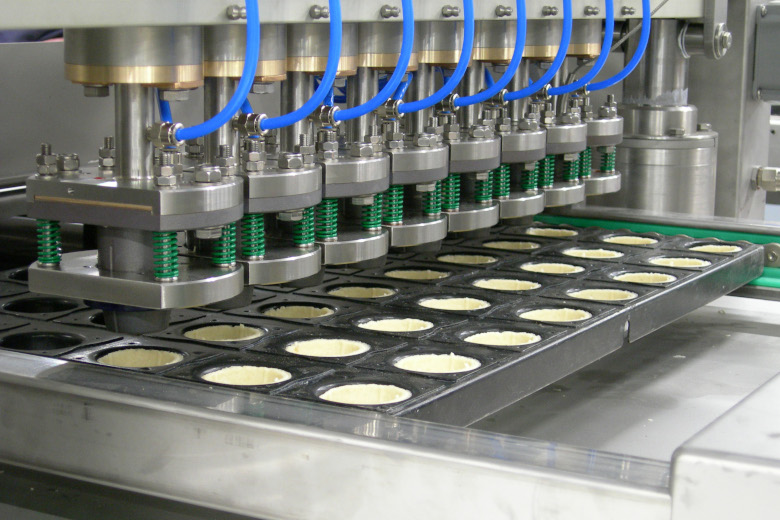
Sweet or savory, pies are a perennial favorite among consumers. Highly specialized production lines are developed to ensure production meets quantity as well as quality needs, efficiently. They are also designed to be operated with ease and safety.
More often than not, technology lines for pie manufacturing are dedicated to certain varieties only, which means they can enjoy the benefits of a high degree of sophistication. Different modules can also easily handle variation or volume expansion when needed.
AMF Tromp pie line
However, the automated line designed by AMF Tromp can flexibly support a wide range of pies, too, either savory or sweet, in a baking tray, in foils, or in paper cups. They can bake the pie shells only, pies with the top opened or closed and pies with or without a lattice decoration. “With this wide range, we can make almost every pie from any culture or continent. We love a good challenge, and our Innovation Center is also open to developing new pies together with potential customers,” says the specialist responsible for pie systems at AMF Tromp, Hans Besems (Executive Product Manager). This diversity is apparent in AMF’s installations making pies worldwide.
Different modules are behind this wide variety: depositors are used for all types of fillings, from more liquid, quiche types, to chunky fillings such as meat for the traditional British pie. “Sweet and savory pies may look alike, but can also be very different, depending on culture and eating habits,” Besems explains. Usually, the spot depositor – or piston depositor – is selected for the process on the AMF Tromp pie line, as the option best suited to pie fillings and the ingredients in them. This system is designed for accurate volume dosing of semi-liquid fillings as well as fillings with large inclusions such as meat chunks or fruit pieces.

Aside from these depositors, a spraying system can also be integrated for water or glazes. It can also spray egg yolk to create a crust. Other decorations such as sprinkles, nuts, chocolates and sugars are dispersed via roll strewers. For even more decoration options, shapes can be added with a rotary molder.
For (pre-)baking the pies, AMF recommends a Den Boer Multibake tunnel oven with impingement heating or a direct-fired system. “Depending on the type of pie, we advise the best possible Den Boer tunnel oven, which fits the process and products baked in it,” Besems explains. It is chosen for the equipment lineup of the pie line because of the baking results it offers for pies, along the entire width of the oven belt. Its airflow and sustainability features also back the recommendation, AMF highlights. “The ROI on ovens like this is very high, and maintenance very low.”
The AMF Vesta Spiral Conveyor is also a part of the pie line, to cool the pies gradually and consistently, before freezing and packaging. It also creates a buffer for large amounts of products coming out of the oven, which supports high-volume manufacturing. Alternatively, a step cooler could also be an option, also offered by AMF Den Boer.
Personalized lines – check
AMF has installed numerous pie lines worldwide, most of them very much dedicated to one type of pie or only a few, as requested. Variations in production mostly mean different shapes or sizes. With the dough remaining the same in most cases, it is mostly the fillings that may vary more frequently.
Pie-making is a complex technical setup. For flaky pies, specific systems are used for carrying and detecting the foils in which the pie base is created, for example. “Not one pie line is exactly the same as another; but, AMF Tromp pie lines can support quick changeovers between various types of pies, because of the configuration set up before even building the line,” Besems explains. AMF’s pie line can handle entry-level volumes up to high-capacity production. “If it’s a dedicated line for a single type of pie, production volumes are often higher, compared to more flexible lines that do several changeovers per shift,” the specialist adds. To optimize production, and mitigate staff shortage, more steps can be automated.
For new product development, AMF Tromp can make changes on existing lines, or create a side step in the process, to allow the production of an additional type of pie. “For instance, two or three pie lines making use of one giant tunnel oven could be very efficient,” Besems suggests.
Or, at the beginning of the process, an AMF horizontal mixer can be set up to feed several pie lines – a step up in efficiency, since the pie shell recipe is often the same.
AMF Tromp pie line, process steps for sweet pie:
- Foil cups de-nester
- Placing cups or foils in baking trays
- Depositing dough billet in foil
- Pressing the pie shell
- Depositing filling sweet
- Top lid placement (a dough sheet, a lattice, or from a rotary molder)
- Crimping unit to press the top and bottom halves of the pie together, with decorative edges possible
- Optional decorative deposit on top of the pie
- Glaze or egg yolk application for a shiny, appealing crust
- Crumble application
AMF Tromp pie line, process steps for savory pie:
- Foil cups de-nester
- Placing cups or foils in baking trays
- Dough billet deposit in foil
- Pressing the pie shell
- Depositing filling, both warm and cold
- Top lid from a dough sheet (shortcrust or puff pastry options are possible)
- Pressing top to bottom halves of the pie with a crimping unit
- Glaze or egg yolk application – crust
- Pop decorations with cheese, seeds, herbs or other toppings, with applicators or strewing units
The article is part of an extended feature on pies, published in Baking+Biscuit International, issue 2 – 2023.


